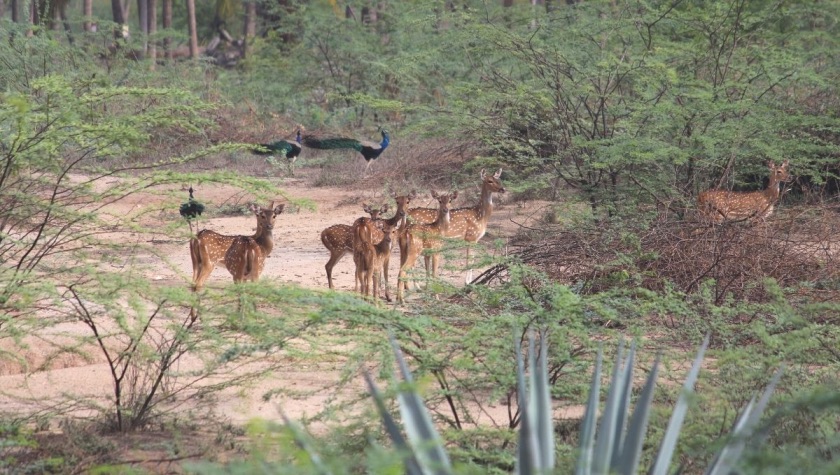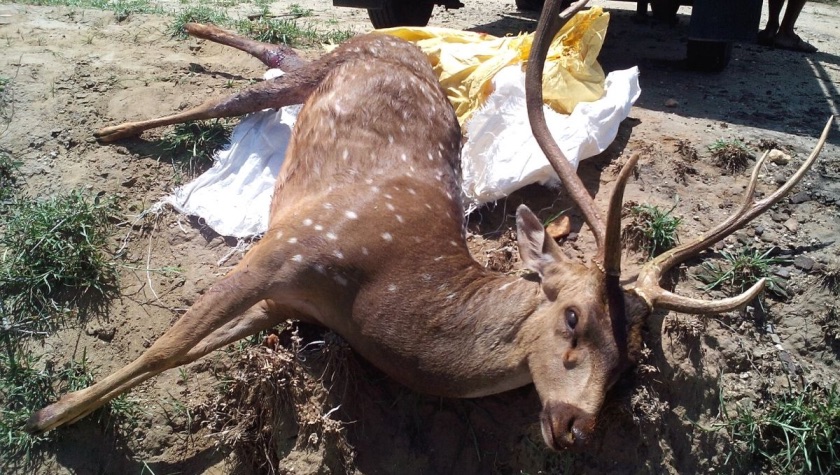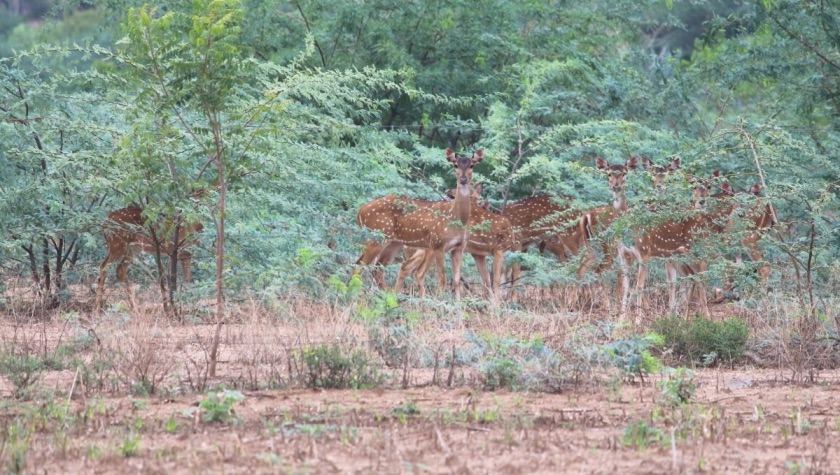In Tamil Nadu’s Pudupalayam village, a 50-acre farm has something unique to offer — if you visit, you might be greeted by a flock of deer, alongside the usual goats and cows.
For the past 20 years, the deer have made this farm their home and have peacefully coexisted with domesticated animals.
Given that apart from some peacocks for company, there is no other wildlife or even a forest nearby, how did this happen?
This is, in part, due to the efforts of R Gurusamy, who gave up his farmland to create a safe habitat and protect wildlife.
Speaking with The Better India, Gurusamy recalls his first encounter with the deer and how he helped increase the population from just three to hundreds.
An act of compassion

“One day in 1998, I saw three spotted deer grazing on grass, alongside my goats. I was amused by the sight, as the deer followed the cattle to feed on grass. To my surprise, they never really left, and instead became a frequent visitor,” he says.
Gurusamy believes that the deer ventured into his territory from the neighbouring Mettupalayam Forest of Western Ghats for water and food. “The region has been experiencing drought conditions and shortage of rainfall for the past 25 years. River Khousikha used to have water for most of the year, but now runs dry. The groundwater table has also decreased owing to overexploitation of the water for irrigation. The deer must have faced the brunt of this,” he explains.
The 70-year-old says, “I have 60 acres of ancestral land, and during those days, practised organic farming over 15 acres of land growing corn, cotton and seasonal vegetables. I dedicated the 45 acres of land for my 100 cows and goats to graze and grow indigenous plants. I use the cow dung from the cattle for making organic fertiliser.”
Gurusamy says the open land with greenery became a safe habitat with assured food for the deer. “The deer made the land home. I eventually limited my farming area to 10 acres and gave away 50 acres for animals,” he says.
He says he felt compassion towards the deer and did not want to harm them or shoo them away. “I had seen some instances of dogs attacking the deer, and I wanted to protect the wildlife. I realised that my farmland would keep the deer safe, away from outside threats,” he explains.
The farmer says that of the three deer, one was male, and the remaining were female. As the animals started breeding, not everyone was kind enough to sympathise with the wild animals.
“The deer population grew over the years, and no one knew about them until 2005. The numbers had increased to the extent that the deer started reaching nearby farms and often damaging the crops in the process. Other farmers felt threatened. Our village and neighbouring districts had a rainfall deficit around the mid-2000s. The deer walked into other farms to access water in their ponds and feed on the crops. Some complained to the forest department and district administration officials,” he says.

Soon, a local newspaper journalist found out about the ordeal, he wrote about the increasing wildlife in the area. Taking cue from the news article, urban dwellers started visiting the place to see the deer, Gurusamy says.
But Gurusamy has no complaints and understands the reason why farmers considered the deer a menace. “They already suffered from a shortage of water, and the production of crops was declining. The damage by the deer added to their losses and was not acceptable to them. Some adopted dogs to chase the deer away,” he says.
However, chasing away deer often scared them, and the wild animals ran helter-skelter, and some became victims to road accidents. The deer population also attracted poachers who started hunting them for meat and trade.
Gurusamy says that he tried to convince the farmers, but in vain. “They all went against me and reported it to the collector. I am struggling to create awareness and change their perception towards the animal to date. It is only my friend C Balasundaram who has always supported my cause. He allowed deer to wander in his coconut grove spread across several acres,” he says.
Balasundram also helped Gurusamy catch two teams of poachers in 2008 and 2010. “We reported the issue to the forest department and have received constant support from the officials. They have promised us 24/7 assistance. To prevent the deer from venturing outside, I built a couple of ponds on the farm. The officials from the forest department fill the water during peak summer months,” he says.
Senthil Kumar, Range Forest Officer, Tirupur, says, “The population of deer has increased tremendously over the past two decades. According to a census conducted in August 2021, the deer population stands around 1,800.”
Senthil says the department assists Gurusamy in protecting the deer and understand their needs. “There is round the clock patrolling by forest guards to control poaching and illegal activities that may threaten the population,” he adds.
A hunt for a safer place
Gradually, some NGOs and environmentalists also started showing support to Gurusamy and his cause.
K Ravindran, an environmentalist and president of the Nature Society of Tirupur, an NGO, says, “I have been following Gurusamy’s work since 2010, and his work is commendable in protecting and increasing the deer population. However, deer is a herbivorous species, and there are no carnivores to keep a tab on the grazing population in the surroundings. Moreover, with banana, tapioca and other dense tree plantations, one can mistake Gurusamy’s farm for a mini forest.”

Ravindran says that the absence of predators has led to an exploding population of deer. “It is a classic example of how a fragmented forest can lead to an imbalance in the ecosystem and disturb the food chain,” he shares.
He adds, “I saw about 110 deer during my first visit over a decade ago, and today there are hundreds thriving in the area. The district collector and forest department officials frequently visit the farm to ensure the protection of the wildlife.”
Considering the increasing threats, Gurusamy has requested authorities to relocate the deer to a safer place.
Echoing Gurusamy’s same thoughts, Ravindran says that relocation of the deer is the need of the hour, but has its own challenges. “The deer is a sensitive animal. Even a shock or long chase can lead to tiredness and can result in death. Tranquillisation of the animal and relocating, a common practice with predators, will not serve as a feasible alternative. The relocation will require a slow and long term plan, and we are exploring solutions to suggest to the officials,” Ravindran says.
Despite the uncertain future for the deer, Gurusamy says that he will continue to protect the wildlife. “I do not need any support and will fight with the farmers for the deer’s safety. The state government has sanctioned an irrigation pipeline to address the water woes for the farmers. Access to water may increase threats for deer, and hence an urgent solution is needed to reduce conflict between humans and wildlife. It would be appreciated if some experts help us,” he says.
Edited by Divya Sethu
No comments:
Post a Comment